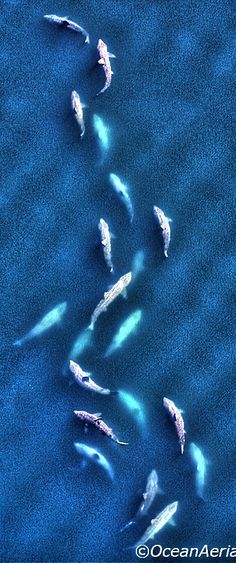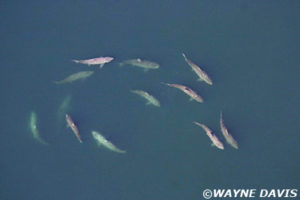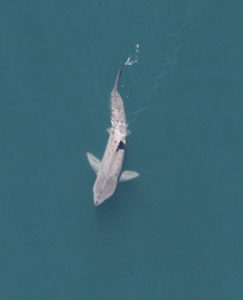Fourteen Hundred Sharks Gather Together : A Well Thought Out Scream by James Riordan

What is scarier than seeing a shark in the water? How about 1,400 of them! Recently, nearly 1,400 basking sharks were seen in aerial photos gathering off the East Coast of the U.S. Basking sharks are not man-eaters, but they are the second largest fish in the world. They can grow up to thirty-two feet in length and weigh as much as five tons. Only the whale shark grows larger. The unusual thing here is that basking sharks have been generally believed to be solitary swimmers. There are several theories about why basking sharks would congregate in such a way. Many other shark species are known to gather for feeding, mating, and protection from predators, but this is usually not so for the basking shark. They are a commercially important fish, as a source of food, shark fin, animal feed, and shark liver oil. They have been over hunted and some species have disappeared whiles others need protection.
 Basking sharks may look ominous, but their open mouth serves to filter zooplankton and other small creatures through their gill rakers.
Basking sharks may look ominous, but their open mouth serves to filter zooplankton and other small creatures through their gill rakers.
The basking shark is a migratory species, found in all the world’s temperate oceans. Its name comes from its habit of feeding at the surface, appearing to be basking in the warmer water there. It is slow-moving and has anatomical adaptations for filter feeding, such as a greatly enlarged mouth and highly developed gill raker. It has a conical snout is conical and the gill slits extend around the top and bottom of its head. The bristle-like gill rakers are used to catch plankton as water filters through the mouth and over the gills. The teeth are very small and numerous, and often number one hundred per row. The teeth are curved backwards with a single conical cusp , and are the same on both the upper and lower jaws. This species has the smallest weight-for-weight brain size of any shark, which may be a factor in its relatively passive lifestyle. A full grown basking shark is usually over twenty feet long and has a mottled greyish-brown skin. Its fin is crescent shaped with a strong lateral keel.
 They usually swim alone or in small schools. Small groups have been seen in the Bay of Fundy and the Hebrides swimming nose to tail in circles in what may be a form of courtship behavior. Despite their large size and threatening appearance, basking sharks are not aggressive and are harmless to humans. A record-breaking sighting of about 1,400 sharks in November 2013 off southern New England included several young sharks, which to Crowe indicates that the group was likely feeding on zooplankton instead of mating. Researchers speculated the sharks may have been in a feeding frenzy on a plankton bloom in the area before setting off on their annual autumn migration south. A survey the National Oceanic and Atmospheric Administration conducted shortly after the 2013 gathering found high concentrations of zooplankton, adding support for that theory.Another possibility is that the sharks were gathering to reduce the drag caused by their open mouths during feeding, allowing them to draft off each other to conserve energy.
They usually swim alone or in small schools. Small groups have been seen in the Bay of Fundy and the Hebrides swimming nose to tail in circles in what may be a form of courtship behavior. Despite their large size and threatening appearance, basking sharks are not aggressive and are harmless to humans. A record-breaking sighting of about 1,400 sharks in November 2013 off southern New England included several young sharks, which to Crowe indicates that the group was likely feeding on zooplankton instead of mating. Researchers speculated the sharks may have been in a feeding frenzy on a plankton bloom in the area before setting off on their annual autumn migration south. A survey the National Oceanic and Atmospheric Administration conducted shortly after the 2013 gathering found high concentrations of zooplankton, adding support for that theory.Another possibility is that the sharks were gathering to reduce the drag caused by their open mouths during feeding, allowing them to draft off each other to conserve energy.
An analysis of satellite and aerial photos found hundreds of them collected in a kind of shark conference in the waters off southern New England in 2013, according to a new study. Scientist suspect the gathering wasn’t related to mating. The animals were all adults or juveniles, according to the research published this month in the Journal of Fish Biology.
Until the study, basking sharks were known to gather occasionally, but only a few hundred at a time at the most and generally in the Pacific, according to experts. The population estimates for the area are “in the hundreds,” marine conservation biologist Boris Worm told the Canadian Broadcasting Corporation. “So 1,400 would be not just a large group, but a large chunk of the population.” Scientists found the unusual gathering by studying more than three decades of aerial photos that were collected in studies seeking North Atlantic right whales. Ten significant aggregations of basking sharks were identified off the coast of Nova Scotia and New England between 1980 and 2013, ranging from 36 to at least 1,398, the largest ever reported.
Observations of these aggregation events are relatively rare. In almost 40 years of aerial surveys for right whales, ten large basking shark aggregation events were opportunistically recorded and photographed. Comparing this information with that collected in a number of earth-orbiting satellite and oceanographic databases and by the NEFSC’s ecosystem monitoring (EcoMon) cruises in the same region, researchers obtained more insight into this behavior.Largest aggregation sighted had 1,400 animalsThe largest aggregation ever recorded on the aerial survey was at least 1,398 animals photographed on November 5, 2013 in southern New England waters. As luck would have it, the NEFSC’s EcoMon survey sampled the same area on November 16 and 17, 2013, providing an estimate of the zooplankton community characteristics in that area at that time of year.Given the apparent presence of juveniles and an abundance of zooplankton on the continental shelf at the time of the event, the study authors say it is likely foraging played a role in the formation of that aggregation. The study also suggests that the animals may be aggregating to draft off each other for more efficient feeding given the immense drag from having their mouths open. They are considered passive and no danger to humans other than that posed by their large size and rough skin. They and the larger whale shark, along with the megamouth shark, are the three shark species that eat plankton.While these aggregations may provide the opportunity for socializing, courtship, and mating, some behaviors suggest they are not solely related to courtship as proposed in previous studies. The reproductive cycle of basking sharks is not well understood, and questions remain about why the animals gather in large groups and how they interact with each other when in them.
 erial surveys meant to locate endangered North Atlantic right whales in recent decades have revealed massive groups of the world’s second-largest fish. Found worldwide, these slow-moving filter feeders pose no threat to humans.And without those opportunistic sightings, “that data was hiding away,” says Leah Crowe, leader of a recent study on the phenomenon and a field biologist at the National Oceanic and Atmospheric Administration’s Northeast Fisheries Science Center. “Our goal is not to do that with our research.” The researchers uncovered about 10,000 documented sightings of basking sharks in the database, and 99 percent were of groups of seven or less.
erial surveys meant to locate endangered North Atlantic right whales in recent decades have revealed massive groups of the world’s second-largest fish. Found worldwide, these slow-moving filter feeders pose no threat to humans.And without those opportunistic sightings, “that data was hiding away,” says Leah Crowe, leader of a recent study on the phenomenon and a field biologist at the National Oceanic and Atmospheric Administration’s Northeast Fisheries Science Center. “Our goal is not to do that with our research.” The researchers uncovered about 10,000 documented sightings of basking sharks in the database, and 99 percent were of groups of seven or less.
Whatever the reason for the mysterious gathering, scientists see it a positive sign for the species. During the 20th century, the slow-moving sharks were intensely hunted until their population eventually collapsed. They’re currently protected in the U.S. and U.K..




No Comment